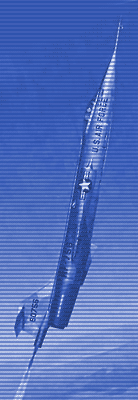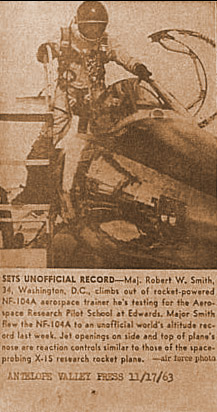The Mission > home

|
|
|
|
|
|
 |
The Mission click on the links below for more of the story...
|
5 A World Record
I should like to add that had Jack chosen to do so, he had the right to have rescheduled and gone before me, once again pointing out just how kind and unselfish a man he was. The flight to pull-up was routine, except that I went to Mach 2.2 this time and the 3.5 g sustained to 70 degree pitch was a first, but I had done it a hundred times in my mind. Visualization is the salvation of a test pilot, because practice is not possible on critical events. As a result, I was convinced that I would be doing what I had planned to do. When the AST left the sensible atmosphere, it was no longer an airplane but a space vehicle, and I had expected that, but what was actually happening I had never anticipated. I felt like a cat chasing its tail, which runs the other way just when he thinks it’s caught. Every time I did something to gain control I just as suddenly lost it in some other motion in another axis than what I had just corrected, and every bit as bad as it had been before. This was outside my understanding of space controls, based on simulations or theory and I felt like I was literally fighting for my life. I knew in space control that I would have to nullify every command with its opposite equal to make it stop and then recover to position with another complete cycle, but there was no rationale for immediate initiation of a second, unwanted, axis of motion with each correction. The unexpected is expected in experimental test, but this was beyond my imagination. I knew, when I took off that I could fly it, but I damned near couldn’t even control it! I might have wished I had not zoomed so high, had I the time to make a wish. The airplane was nearly uncontrollable from the time I got to the point in the climb where I had to rely solely on the reaction control system (RCS) for controlling the craft, until what seemed an eternity later, when it again became an airplane in the 70 degree dive toward earth. I fought every inch of the way to avoid complete loss of control, but not only in the most difficult, pitch axis, in all three! That was incomprehensible based on my training, and highlighted by adding a third serious problem, roll, where I expected virtually no work to do. I landed convinced this airplane could not be used as a trainer, without significant analysis, redesign and changes, an opinion I wrote up in the aircraft log and announced to Lockheed. I had been able to retain control but couldn’t see any way to improve significantly with practice because of the inexplicability of the motions and my margins from complete loss of control were small. I expected and was ready to cope with zero stability, which I fully understood and even ready for negative stability possible on the climb during transition from air to space. I had experienced both in a variable stability F-101. But cross-coupling outside the atmosphere shouldn’t exist, and this was exactly as if an airplane’s inertial cross-coupling had been added to the equation, but that was impossible outside the region of aerodynamics. Not until some days later did I find out that all three axes of the RCS had been wired incorrectly. As a result, I was introducing the same rate of a disturbance on another axis as I was demanding on the one I intended to correct. Even the gyroscopic coupling effects, we were unaware of at the time, were compounded by that hardware problem. There was no wonder it was beyond any expectations or logic. With that news I was very pleased that I was able to maintain control in spite of that very significant glitch with all three axes of the control system. After all, except for understanding of the theory, it was my first actual use of reaction controls. Maybe even more importantly, it proved something during test that we could never have discovered about the ultimate capability of the AST. This unique aircraft, put together so austerely actually exhibited a great deal of margin, which was a great safety plus for the planned training. There is no doubt that the excess thrust levels, resulting in quick response against unusual variation in attitude had a lot to do with my success in saving a potential disaster. Even if I encountered the situation in a simulator of today’s sophistication, where a “crash” would be harmless, I suspect it would have taken many, many attempts and crashes to begin discerning a pattern of logic in the misconnection. On this flight I had nary a clue and was barely hanging in! The ground stations, radar and visual (Askania System) were extremely accurate and recorded my peak altitude at 118, 860 feet. This new record altitude exceeded the Russians, who held the official mark of 113,800 feet, by more than the margin of 3% required to set an official world record. Such marks required a protocol for certification, even though the Edwards tracking systems were most qualified in the world for precise accuracy of altitude and even attitude, as well. Pre-approval by the Federation Aeronautique Internationale (FAI) in Paris had not been requested by the Air Force, though Lockheed had paid the license fee. Who ever said the French were cooperative, but this was not their fault? It was one of the most interesting and satisfying flights of my flying career, in part because it was so unique, and the events so unexpected, but also because it made me feel for the first time like an experimental test pilot, one of my flying goals. That was my last flight with Lockheed. Not until recently, I learned that Jack flew that same airplane the afternoon of that same day I wrote it up, which was logged as a very routine flight for directional stability. This strikes me as very strange because that was well within the regime already tested on # 756, the designated stability test bird. Clearly, that flight was a post-maintenance checkout of the corrections Lockheed maintenance had made on the RCS control problem that I had encountered. The very morning after that, 23 Oct, Jack also went to the full 70-degree climb for his first time and reached 118,400 feet, only 400 short of my record but suffered full loss of control over the top and fell out of control for 85,000 feet before he successfully recovered control and landed. I remained unaware of Jack’s max zoom, until recently, when I read his biography, written after his death to cancer. He did tell me later that he fell out of a zoom, but I assumed it was one of his lower altitude flights, possibly the one the afternoon I completed mine, since I was unaware that he didn’t zoom then. He also informed me that Lockheed tested the RCS and discovered it was improperly connected, so I was satisfied to continue the project without any further actions. Jack and his big boss, Jack Real, one of the long-time great test executives of Lockheed, came to Edwards and presented me a plaque for my record flight, a couple of months later and Jack, such an unassuming guy, never mentioned that he virtually tied my record. It seems impossible that both he and the company would have ignored my write-up and flown the airplane, twice, before finding their wiring error, which could have been noticed in any careful ground firings, and I don’t believe either would have allowed it. I recently read a very brief biography of Jack and learned he studied basic engineering at the University of Saskatchewan in 1945 and the Empire Test Pilots School (British) in 1952. Obviously, based on the times, neither of these would have included studies related with space flight and controls, as our own TPS did not, even in 1963. I recently discussed Jack Woodman with NASA astronaut Vance Brand (Commander and Pilot of multiple Shuttle flights) who was a fine young Lockheed test pilot, working with Jack at that time. He described Jack in glowing terms, an opinion I share with Vance. He went on to say Jack did not delve into engineering aspects in detail. He was more inclined to rely on the engineers for a test plan, study and understand it, and then worked hard to perform it well. It never occurred to me until later that the technically and mathematically inclined Lockheed engineers, who designed and sized the RCS, may not have envisioned how it related to piloting the AST, but assumed Jack would relate to them, instead. I conclude it’s most probable that Jack’s unfamiliarity with the dynamics of space flight and control systems caused him to lose control of the AST, even though the wiring problem had been corrected before the flight and the RCS performed properly. That conclusion is supported by another such event, which occurred less than two months later, with another test pilot who did not understand the uniqueness of space dynamics and control. After the RCS was corrected, I never had any problem with the RCS when flying within the recommended max profile, until I intentionally exceeded the instrument limitations. The AST was not easy to fly but was designed only to train technically expert test pilots, and it performed as intended. I did note a continuing coupling of axes in yaw and pitch, but not of significant magnitude after that first flight. The aircraft was exceptionally well qualified for the intended mission. I never had benefit of data collected from my flights, or anyone else’s until after I had flown my final max zoom, however, when data were finally reduced on the last two zoom flights ever flown, those by famous test pilot Chuck Yeager, the gyroscopic effects, which couple them, were identifiable in his data from those two flights, which will be discussed further. Finally, I understood why I was always having to work at controlling yaw so much more than I had expected. Another of my recent discoveries is merely of incidental historical interest. Jack’s direct boss in Lockheed test was Ed Brown, who later tested the zero launch take-off (ZEL) which launched the German F-104G, from a stationary truck with a large jet-assisted-takeoff rocket attached to it. Ed flew his only flight a day after Jack’s final incident. That flight may have been a sop to a supervisor, who wanted to try it out, but who also remembered Jack’s difficulty just the day before, since he quit zoom attempt and flew only to 67,000 feet, meaning an abort almost at the very start of pull-up. Joint testing thus ended on 24 Oct 1963.
|
| previous section | next section |
 As good luck would have it, I was scheduled to
fly the next zoom on the afternoon. Based on
Jack’s success, I felt ready for full zoom, from
past flying experience and my aeronautical
engineering, as well as the training and
simulations at ARPS, so was delighted for the
opportunity to go first.
As good luck would have it, I was scheduled to
fly the next zoom on the afternoon. Based on
Jack’s success, I felt ready for full zoom, from
past flying experience and my aeronautical
engineering, as well as the training and
simulations at ARPS, so was delighted for the
opportunity to go first.